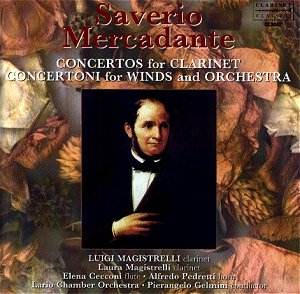Think Italian music, think opera … but throughout
the 19th century there was an ever-increasing movement
against the exclusivity of this form by a growing number of rebellious
Italian composers. Although Mecadante was a prolific composer
of operas (some 60 of them) he is best remembered as a notable
composer of non-operatic music for the clarinet. These works are
typically light-hearted, humorous and ironic with a measure of
pathos and they all share prominent impressive virtuoso writing
for the clarinet.
Mercadante’s Concerto in B flat major, full of
Italian joie de vivre, lasting some seventeen-and-a-half
minutes is cast in two continuous movements. The first Allegro
Maestoso is very reminiscent of Haydn and Mozart, too reminiscent,
perhaps, for all the familiar flowery decorations are here. But
then, suddenly, my attention was aroused and held at the arrival
of the Tema con Variazioni second movement. It has the
most catchy tune which forms the basis of a set of five variations.
In this sparkling movement the clarinet at more than one point
sounds as if it has a fit of the giggles while the orchestra seeks
to strike a more dignified pose. Luigi Magistrelli’s spirited
virtuosity, joy and humour make this movement sheer delight. Mercadante’s
more formal, more serious and introspective (especially in the
central Largo) E flat major Clarinet Concerto is nevertheless
not short on melodic inspiration. In this case merriment is mostly
reserved for the cheerful Polacca final movement.
The three Concertones are quite short and probably
date from Mercadante’s student days. These works are clearly experimental
allowing the budding composer to flex his muscles and show off
his great sense of fun, his adept use of wind instruments (with
prominence given to the clarinets), novel harmonies and timbre
and a very definite popular approach - for example, the flute’s
part in Concertone No. 1 very definitely appeals to the balcony.
The familiar ‘Voi che sapete’ from Mozart’s The Marriage
of Figaro is the theme for a set of variations that comprise
the last movement of this attractive little work. Concertone No.
2 begins in a more classical, more serious frame of mind with
a rather self-important romantic tune for the horn echoed derisively
by the clarinets tittering at the outraged horn’s expense supported
later by the equally insulted orchestra. But mostly it is music
of delicious irony: humorous, joyful virtuosity for the two clarinets
and the flute. You sense too that Mercadante is also lampooning
operatic styles of his day in the final pages. The song of the
cuckoo seems to intrude into the Mozartian elegance and refinement
of the opening pages of the Concertone No. 3. It is not long before
Mercadante’s sense of fun is sent skylarking again with more joyful
virtuoso writing for the flute and clarinets leaving decorum to
horn and orchestra.
Cheeky, sunny Italian clarinet and wind concertos,
delightfully played with great brio and a keen sense of humour.
A real tonic - guaranteed to make you smile.
Ian Lace
